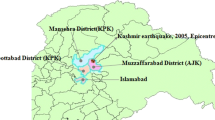Abstract
A total of 116 reinforced concrete building structures were surveyed after the earthquake that devastated Wenchuan, China, in 2008. Original construction drawings were obtained for all these buildings. The buildings were ranked according to the degree of damage caused by the ground motion. Two different methods were used to define degree of damage. In both cases, strong correlation was found between the frequency of damage and a vulnerability index proposed by Hassan and Sozen. The index was first calibrated using data from Turkey and it was later tested by O’Brien et al. using data from Haiti. The observed correlation confirms that the index can be used effectively to prioritize resources for building strengthening.



























Similar content being viewed by others
References
ACI Committee 314 (2012) Guide to simplified design for reinforced concrete buildings. ACI 314R–11, Farmington Hills, MI, USA
ATC (1996) Seismic evaluation and retrofit of concrete buildings. Report ATC-40, Redwood City, California, USA. Applied Technology Council
Bazzurro P, Luco N (2005) Accounting for uncertainty and correlation in earthquake loss estimation. In: Proceedings of the ninth international conference on structural safety and reliability, Rome, Italy, pp 2687–2694
Dönmez C, Pujol S (2005) Spatial distribution of damage caused by the 1999 earthquakes in Turkey. Earthq Spectra 21(1):53–69
Guevara LT, García LE (2005) The captive- and short-column effects. Earthq Spectra 21(1):141–160
Gur T, Pay AC, Ramirez JA, Sözen MA, Johnson AM, Irfanoglu A, Bobet A (2009) Performance of school buildings in Turkey during the 1999 Duzce and 2003 Bingol earthquakes. Earthq Spectra 25(2):239–256
Hassan AF, Sözen MA (1997) Seismic vulnerability assessment of low-rise buildings in regions with infrequent earthquakes. ACI Struct J 94(1):31–39
Mario ER (2005) Evaluation and design of masonry dwellings in seismic zones. Earthq Spectra 21(2):465–492
National Standard of the People’s Republic of China (2001) Code for seismic design of buildings. GB 50011-2001. Ministry of Construction of the Peoples’ Republic of China, Beijing. China (in Chinese)
National Standard of the People’s Republic of China (1978) Code for seismic design of industrial and civil buildings. TJ 11-78. State Infrastructure Commission of the Peoples’ Republic of China, Beijing. China (in Chinese)
O’Brien P, Eberhard M, Haraldsson O, Irfanoglu A, Lattanzi D, Lauer S, Pujol S (2011) Measures of the seismic vulnerability of reinforced concrete buildings in Haiti. Earthq Spectra 27(s1):373–386
Otani S (2000) Seismic vulnerability assessment methods for buildings in Japan. Earthq Eng Eng Vib Seismol 2(2):47–56
Shiga T, Shibata A, Takahashi T (1968) Earthquake damage and wall index of reinforced concrete buildings. In: Proceedings, Tobuku District Symposium, Architectural Institute of Japan, No. 12, December 1968, pp 29–32 (in Japanese) http://cidbimena.desastres.hn/docum/crid/Diciembre2005/pdf/eng/doc10434/doc10434-contenido.pdf
Sucuoğlu H, Yazgan U, Yakut A (2007) A screening procedure for seismic risk assessment in urban building stocks. Earthq Spectra 23(2):441–458
United States Geological Survey (2008) Magnitude 7.9—Eastern Sichuan, China 2008 May 12 06:28:01 UTC USGS, http://earthquake.usgs.gov/earthquakes/eqinthenews/2008/us2008ryan/
Wang ZF (2008) A preliminary report on the great Wenchuan earthquake. Earthq Eng Eng Vib 7(2):225–234
Whitman RV, Anagnos T, Kircher CA, Lagorio HJ, Lawson RS, Schneider P (1997) Development of a national earthquake loss estimation methodology. Earthq Spectra 13(4):643–661
Yin ZQ (2004) Damage analysis on earthquake and seimic fortification criterion. Chinese earthquake press, Beijing (in Chinese)
Yu HY, Wang D, Yang YQ, Lu DW, Xie QC, Zhang MY, Zhou BF, Jiang WX, Cheng X, Yang J (2008) The Preliminary analysis of strong ground motion characteristics from the Ms8.0 Wenchuan earthquake, China. Tech Earthq Disaster Prev 3(4):321–336 (in Chinese)
Zhou RZ, Lei JC, He YL, Li XG, Wang SY, Ye YQ, Liu YF, Kang CC, Liang MJ, Ge TY, He Q, Huang W (2008) The surface rupture and hazard characteristics of Wenchuan M8.0 earthquake in Sichuan Province. Chin J Rock Mech Eng 27(11):2173–2183 (in Chinese)
Acknowledgments
The authors thank the members of the HIT field team: Dr. Zhao Junwei, Associate Prof. Qi Jialian, Prof. Wu Zhenyu,. Together with you, our technical assistance tasks after Wenchuan Mega-earthquake 2008 were accomplished. The leading author appreciates the cooperative research provided by Purdue University. Thanks to Madeline D Nelson for checking all data. This research was funding by National Science of Foundation of China (No. 51108124).
Author information
Authors and Affiliations
Corresponding author
Rights and permissions
About this article
Cite this article
Zhou, W., Zheng, W. & Pujol, S. Seismic vulnerability of reinforced concrete structures affected by the 2008 wenchuan earthquake. Bull Earthquake Eng 11, 2079–2104 (2013). https://doi.org/10.1007/s10518-013-9517-5
Received:
Accepted:
Published:
Issue Date:
DOI: https://doi.org/10.1007/s10518-013-9517-5




